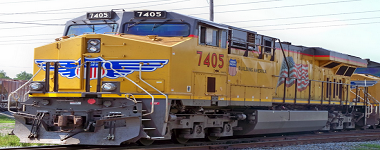Week 41 of 2018 shows same week total rail traffic (from same week one year ago) improved according to the Association of American Railroads (AAR) traffic data.

Analyst Opinion of the Rail Data
Rail continues to have relatively good growth seems to be running out – and the overall rate of growth in 2018 has slowly decelerating.
We review this data set to understand the economy. If coal and grain are removed from the analysis for carloads, this week it expanded 0.5 %. We primarily use rolling averages the analyze the data due to weekly volatility – and the 4 week rolling average for the intuitive sectors declined from 3.1 % to 1.3 %.
Intermodal transport growth remains strong year-over-year – but currently, the rate of growth is also marginally slowing.
The following graph compares the four week moving averages for carload economically intuitive sectors (red line) vs. total movements (blue line):
.This analysis is looking for clues in the rail data to show the direction of economic activity – and is not necessarily looking for clues of profitability of the railroads. The weekly data is fairly noisy, and the best way to view it is to look at the rolling averages (carloads [including coal and grain] and intermodal combined).
A summary of the data from the AAR:
For this week, total U.S. weekly rail traffic was 549,757 carloads and intermodal units, up 1.7 percent compared with the same week last year.
Total carloads for the week ending October 13 were 263,787 carloads, up 0.4 percent compared with the same week in 2017, while U.S. weekly intermodal volume was 285,970 containers and trailers, up 3 percent compared to 2017.
Seven of the 10 carload commodity groups posted an increase compared with the same week in 2017. They included petroleum and petroleum products, up 2,824 carloads, to 11,783; metallic ores and metals, up 815 carloads, to 23,128; and miscellaneous carloads, up 387 carloads, to 10,332. Commodity groups that posted decreases compared with the same week in 2017 were nonmetallic minerals, down 2,849 carloads, to 35,721; chemicals, down 514 carloads, to 30,416; and forest products, down 34 carloads, to 9,927.
For the first 41 weeks of 2018, U.S. railroads reported cumulative volume of 10,781,980 carloads, up 1.9 percent from the same point last year; and 11,402,578 intermodal units, up 5.8 percent from last year. Total combined U.S. traffic for the first 41 weeks of 2018 was 22,184,558 carloads and intermodal units, an increase of 3.9 percent compared to last year.














Leave A Comment